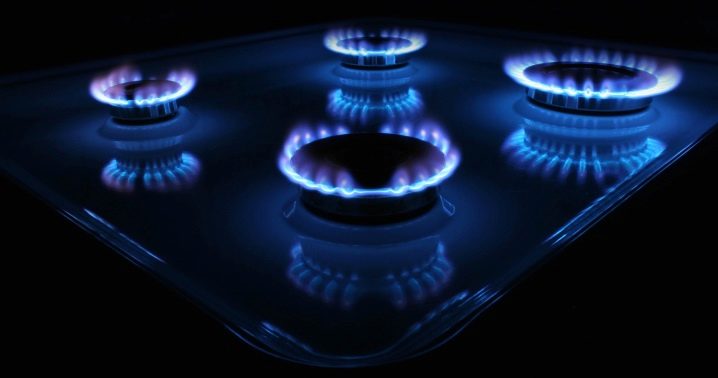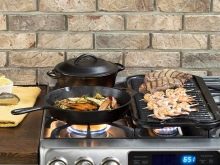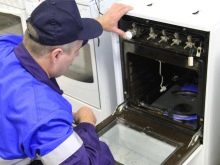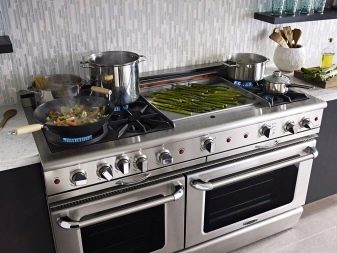Gas stove power and gas consumption per hour

Almost ubiquitous gasification of residential houses creates comfortable conditions for cooking and heating with boilers. However, a new task arose before users - buying a meter and choosing a stove in accordance with the indicators of how much gas it consumes per hour. Fuel consumption depends not only on the power of the burners, but also on the habits of the residents and the mode of use of the stove.

GOST indicators
The power of the burners on a gas stove is measured in kilowatts (kW). At the request of GOST 10798-85, these household appliances must meet the following technical characteristics:
- have several burners - from 2 to 4, each of which must ensure the normal maintenance of a flame that is resistant to air currents;
- have a reduced (0.6 kW), increased (2.6 kW) and normal (1.7 kW) thermal power;
- have the power of the main burner per oven unit 0.08 kW / dm³, oven frying burner - 3 kW.
Usually, the parameters of the burners are indicated in the product data sheets and differ depending on the models and the country of production. On average, the aggregate capacity of all burners is 10 kW. GOST standards apply to all household gas stoves, except for tourist and those that remove combustion products into the chimney.



How to determine the expense
Let's say you need to calculate the gas consumption of a stove. The calculation of this indicator is straightforward. Gas consumption is measured in cubic meters per hour (m³ / h). First of all, you need to find the sum of the capacities of all burners. Then divide it by the calorific value of the gas, which is 8–11 kWh / m³. So, if we add up the parameters of two medium, one low and increased fuel consumption burners and the oven burner, we get the result of gas consumption by a four-burner stove: (0.6 kW + 2.6 kW + 1.7 * 2 kW) / 8 kW * h / m³ = 1.2 m³ / hour.
This is the maximum for a device with similar specifications. If there is a manual for the device, this parameter will be indicated in it. If the house has an old stove and there is no documentation, you can take the average. Such household appliances consume from 1.2 to 2.5 m³ / hour of fuel. You use natural or liquefied gas - it doesn't matter. Applying this calculation result, if the stove operates on average for one hour every day, the gas consumption per month will be: 1.2 m³ / h * 30 h = 36 m³.
The meter will help to correctly determine the exact amount of fuel spent. Of all household appliances that use gas, the stove consumes the minimum amount. If the house has a gas water heater or a boiler, costs can increase tenfold. Then the consumption calculations for the burners are almost neglected. For example, when using autonomous gas heating, fuel consumption per month can be 300–400 m³ during the heating season.



Which is better to put a counter
Most consumers use gas exclusively for cooking. With the installation of a meter, the payment for the use of fuel is significantly reduced. The savings in this utility bill allows you to quickly recoup the purchase and installation costs of the sensor. However, the choice of the device should be taken seriously. When buying, consumers are faced with various types and modifications of metering devices.
Each device has its own interval of the considered flow rate, which is determined by the index G. For the room, a meter is selected that has a range that covers the minimum use of gas (the indicator of the lowest-power device) and the largest (the sum of the consumption of all devices). If this condition is met, the device works most accurately and without failures.

The maximum amount of fuel that the meter can measure is called the throughput. It is indicated on the body of the device and has the following meanings.
- G1.6 can pass 1.6-2.5 m³ / h of gas.
- The G2.5 is capable of calculating the volume from 2.5 to 4 m³ / h.
- G4 - from 4 to 6 m³ / h.
- The G6 has a capacity of 6-10 cubic meters per hour.
- G10 - from 10 to 16 cubes.
- G16 - from 16 to 25 cubic meters.




When only a gas stove is functioning in the house, expenses are small and do not exceed 1.2 - 2.5 m³ / h. It makes no sense to install a device that counts large volumes of fuel. Install the device with the lowest flow rate G 1.6 or G 2.5. Errors in calculations of other devices will bring negative results. They can either underestimate or exceed the true flow rate. Incorrect selection of the counter will ultimately lead to the fact that the device will have to be replaced.

Counter for an apartment with a boiler or column
Determining the maximum amount of fuel consumed is not difficult when the apartment is equipped only with a gas stove. It is more difficult to calculate this indicator for residential premises with devices for heating water or with a gas boiler. To do this, you should take the technical documentation for all available gas devices and add up the maximum volumes of fuel that they consume. In this case, even those gas equipment that you rarely use should be taken into account. Sometimes in private houses, more than one meter is used for the most accurate calculation of fuel consumed.
For example, if a boiler and a gas stove are installed in the house, then the minimum values of the technical data of the hob can be 0.9 cubic meters, and the maximum summed up with the heating unit can reach 10 m³. Gas meters capable of covering such a range are simply not on sale. Then a device with an index G1.6 is mounted on the stove, and G10 on the boiler, as in our example, or another, selected in accordance with specific consumption parameters.


Installation and purchase in this case will cost more. There are nuances in payment if there are two metering devices. To pay off the debt of utilities, you will need to open a personal account for each. In the case of double-circuit boilers, the range gap turns out to be small, it is much easier to pick up a meter, it is easier to make payments.
For an apartment with a dispenser that uses fuel, you can choose a meter without any problems. An instantaneous gas water heater usually uses between 1.5 and 2 m³. Plus, the consumption of the slab is 1.2–2.5 m³. In order to pass such an amount of gas, a metering device with an index G4 or G6 is installed.


What type of device to prefer
In specialized stores, you can buy metering devices of the following types.
- Electronic - they produce the utmost accuracy of measurements, are characterized by small dimensions, an absolute absence of sounds during operation, and simple adjustment. The disadvantages include the high cost of such devices.
- Rotary - compact, quiet, affordable, durable, but have measurement deviations and a short verification period (5 years).
- Membrane - have a solid construction, are reliable, have a relatively low price. However, in operation, they make noise (buzz) and are large in size. They are used more often to measure small gas flows - they give accurate readings. The device is checked every 10 years.
- Volumetric - are characterized by high throughput and affordable prices. But they are large in size and make noise during operation.




When only a stove and a column are installed in a living room, electronic and rotary meters are mounted. In the presence of a personal heating system, volumetric, rotary and electronic devices are used. When choosing a sensor, consider the direction of the gas flow in your home. Depending on which side it is supplied from, there are right-handed and left-handed meters.
In order to spend less on purchasing a gas meter, you can select a stove in advance, and look for a meter for it. For example, if the family is small and you do not need to cook many dishes, then a stove with two low-power burners is sufficient. Then you need a metering device with a small bandwidth and a more affordable price.
Combined options are very popular now, when the hob uses gas and the oven uses electricity. Such ovens have more functions and are more convenient to use. However, gas is much more economical and cheaper. The monthly gas consumption for the oven does not exceed 10 cubic meters.
The model and parameters of the stove, the number of burners do not affect the monthly fuel consumption. Consumption is directly proportional to the amount of food prepared. The method of operation of the device, the number of residents and their eating habits are also important. In the cold season, the amount of used fuel increases, since gas is spent on heating water, heating, while in summer the consumption is always less.


Gas saving tips
Follow these simple recommendations to reduce gas consumption when cooking on the stove.
- Use only the strength of the fire that is sufficient for the cooking, frying or stewing process, do not exceed the heat.
- After boiling water or broth, the flame can be squeezed to a minimum.
- The fire will heat the bottom of the cookware faster and more efficiently if it touches it lightly, rather than covering it from all sides. It has been proven that the highest burner temperature is at the top of the flame.
- When the container is placed on the hotplate, close it with the lid. The boiling and cooking process is then faster. Other food is cooked only with the lid open, but heating water to a boil or reheating the dishes initially with the lid closed will not harm the dish itself.
- Make sure that there is no draft in the room where the cooker is located, in which part of the heat energy is directed to the side, wasted.
- Close the valve when the food is already cooked. Or press as soon as the water boils.
- Do not heat the contents in a cookware with a screwed flame. In this case, the walls of the tanks give off heat faster, the gas consumption reaches 10-15%.
- Try to cook smaller meals in the oven less often. It takes a lot of resources to warm it up.



If you have a gas water heater installed in your apartment, you should save water that needs heating. Draw water into the sink when washing dishes, and use the running water for rinsing. It has been noticed that if you take a shower, and not a bathroom, much less hot water is consumed. To save money, special shower heads are sold.
In the presence of individual heating, the largest amount of gas is spent on heating the home. Insulate the house, install a boiler with an automatic thermostat. Reduce the temperature 2 degrees below your comfort level. If possible, use a solid fuel boiler, as it is more economical than a gas one.
For any user of utilities, it will be useful to know the fuel consumption and power of his gas stove, boiler, column. Then the monthly incoming bills will not surprise with their numbers. The ability to independently make calculations will help to compare the maximum and minimum consumption of gas devices, to choose the right meter in accordance with the parameters.


When buying a meter, do not destroy the technical documentation for them, it may come in handy when installing or replacing them.For old-style gas stoves, documents for which have been lost, you can take averaged indicators.
The gas flow test is shown in the following video.













The comment was sent successfully.